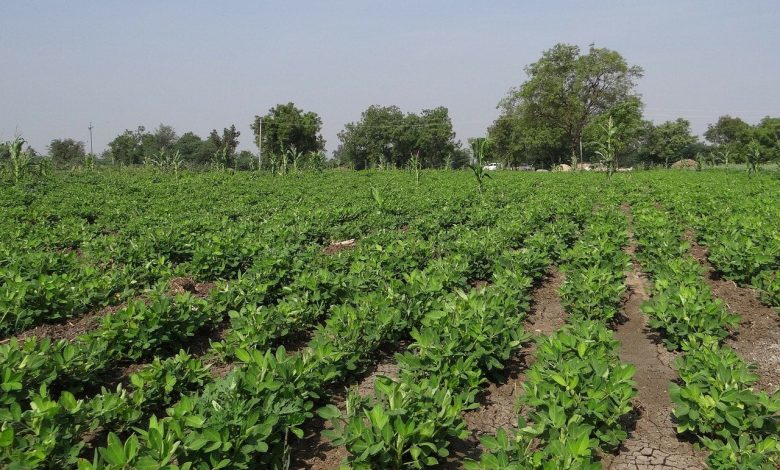Peanut Cultivation in India – How to Grow the Peanut

Peanut, popularly known as groundnut, is a leguminous crop cultivated for food purposes. It is found exclusively in tropical and subtropical areas worldwide. It is sometimes treated as a grain because the seed can produce oil, and the crop is classified as an oil crop. The seed’s oil content is estimated to be around 44-50%. China is the world’s enormous producer of peanuts, with a production volume of 16,685,915 tonnes per year. India comes second with an annual production of 6,857,000 tonnes. China and India together produce more than 50% of the world’s production.
The groundnut (Arachis hypogaea) is a genus of the legume or “bean” family. It is considered endemic to South America. They are known by many other local names such as groundnuts, amla peas, monkey nuts, pygmy nuts and groundnuts. Despite its name and appearance, the peanut is not a nut but a legume.
Peanut Cultivation Process
When you start peanut farming, choose the equipment made according to the agriculture practice, which is most important. However, in peanut cultivation, you can choose a popular tractor brand. So you should be aware and careful about the equipment involved in farming. However, you should buy the popular tractor models and other equipment. You can choose Mahindra 275 tractor models and many more. Let’s look at the process of peanut farming with complete specifications.
Suitable Soil for Growing Peanut
Farmers perfectly grow the Peanut in well-drained sandy clay loam and sandy loam soil. For groundnut farming, high fertility, 6.5-7.0 pH and deep, well-drained soil are ideal. The optimum soil temperature is 30°C for the good germination of peanuts. However, low sowing temperatures delay germination and increase seed and seedling diseases. Therefore, you must test the Soil before starting peanut cultivation.
Crop rotation of Peanut
Crop rotation is a significant process in peanut farming; this is conducive to reducing soil-borne diseases and nematodes and helps to efficient nutrient utilization. It also assists in reducing the incidence of weeds. Maize, pearl millet or sorghum. To minimize the incidence of soil-borne diseases, it is recommended not to grow Peanut after Peanut, tobacco, or cotton.
Application of Fertilizers and Manures of Peanut
A balanced fertilizer application which is based on soil tests should provide ample levels of especially potassium, calcium, phosphorus, sulphur, magnesium and calcium. Nutrient availability relies on organic matter content, soil pH and rate of release of nutrients from the soil minerals. Other necessary ions like boron, copper, iron, nitrogen, and manganese may be little in alkaline soils (pH >8.5), while acid soil may be deficient in manganese, molybdenum, phosphorus, potassium, calcium, sulphur and nitrogen. Therefore, depending on targeted yields and soil nutrient status.
Manure Application in Peanut production
In groundnut cultivation, 1 0 – 1 2 t ha-1 of poultry manure or 20 t ha-1 of well-decompose field manure should complete at least 1 month before sowing. You should add it to the Soil for good plant growth and improvement in soil structure.
Fertilizers Application of Peanut Crop
The main fertilizer components in peanut farming are Phosphorus, Potassium, Calcium, Nitrogen, Sulphur, Iron, Zinc and Calcium. You can correct the deficiencies of copper, boron, manganese, molybdenum and magnesium through soil applications of these nutrients when symptoms appear, and it depends on agro-climatic conditions and soil type.
How to Select the Peanut Seed
Well loaded beans and bold are picked for shelling about a week before sowing. The viability of the kernels may deteriorate after prolonged peeling and storage and are subject to storage insect damage. Plants produced from thicker kernels were found to be correspondingly better than smaller kernels in their rate of emergence, number of successful shoots, dry mass of roots, number of primary branches and leaves, twigs, total dry matter and pod yield.
The seed Treatment Procedure for Peanut
To control seed and seedling disease-causing pathogens, seed before sowing should be treated with Bavistin® (a.i. 5 0% @ 2 g kg’ 1 seed) or Thiram® (a.i. 5 0% @ 3 g kg – 1 seed). ) Where few rhizobia have been found in Soil, seed can be inoculated at the time of sowing by field inoculation to ensure good nodulation.
The Seed Rate and Spacing of Peanut
The seed rate depends on the variety ( Valencia, Spanish or Virginia), the runner or bunch type, the seed mass, and the germination rate of the seed lot. The recommended population for bunch varieties is 3,30,000 plant hectare-1 (about one plant per (10 x 30 cm). In the case of spreading varieties and semi-spreading, the recommended population is 250 000 plants per hectare-1 (one plant per 40 x 10 cm).
Sowing Procedure of Peanut
- The sowing of peanuts during the rainy season begins with the onset of rains, usually by the third week of June.
- Check the Soil before sowing for optimum moisture after irrigation before sowing to ensure good germination.
- At the sowing time, the seed is kept at 5-6 cm. Put it in the Soil at a depth of Compact the Soil around the seed to ensure it is firmly in contact with soil moisture for rapid and uniform germination. The use of a seed drill with a packing wheel is useful to ensure uniform germination.
- When sowing manually, ensure that the same person completes plots in each block to reduce variation within blocks due to unequal sowing due to human differences.
How to Control Weeds in Peanut Crop
During the 45 days of its growth, weeds cause much damage to the peanut crop. After sowing, the most intricate period of weed competition is from 3 to 6 weeks. The average yield loss due to weeds is about 30%, while the yield loss due to weeds can be as high as 60% under poor management. Therefore, it is beneficial to control weeds both mechanically and chemically during the first 6 weeks of groundnut growth.
Along with the process of peanut farming, you should also consider the equipment that will help to boost the yield. Cultivators, Tillers and tractors are crucial factors in peanut farming. You can easily find the Swaraj 744 in India and many more models online.
For further information regarding peanut farming in India and any other farming in India like Pear Farming, Date Palms Farming, Gooseberry Farming stay tuned with us.





